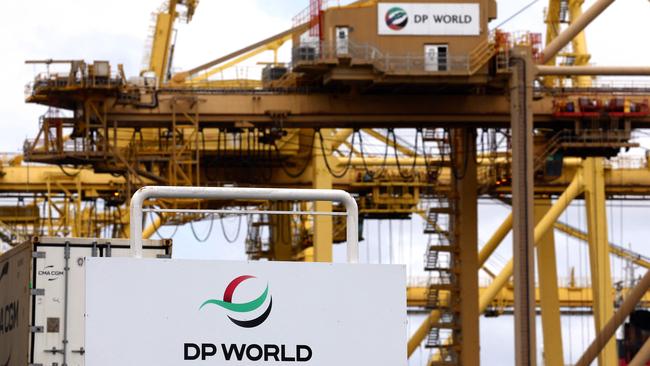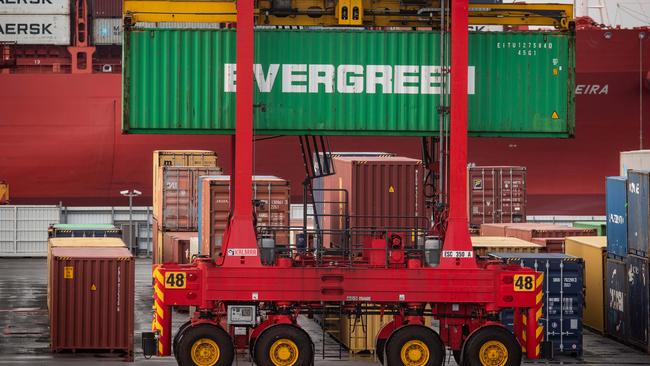
At that time, its larger rival Patrick – now owned 51 per cent by Brookfield Asset Management and 49 per cent by Qube – decided to fully automate its Sydney terminal. Given that Patrick had already automated Brisbane, the combination of the two plus an efficient workforce in Melbourne where there is only part automation, meant that Patrick’s labour component would be far lower than DP World: a dangerous situation for any enterprise.
Around 2015 the Dubai royals had owned DP World (formerly P&O) for less than 10 years. The stevedoring operation covers about 70 countries and in 2015, like most international companies, it invested where it got the best return. And the best returns did not come from Australia.
When Patrick’s current enterprise agreement was negotiated in 2022 its staff was given a 7 per cent pay rise in 2023 and 5 per cent this year. The next two years track CPI.
These were big pay rises but the Brisbane-Sydney automation limited their impact. At the time Australia’s inflation rate was higher than 7 per cent but, more importantly, Patrick agreed to the big pay rise in exchange for eliminating clauses in its enterprise agreement that gave unions part control over management. This delivered a productivity offset.
But DP World’s workers are now being paid significantly less than Patrick’s workers. If DP World matches the Patrick pay rates then, given its greater labour intensity, DP’s labour costs will skyrocket far above Patrick. Worse still, its current agreement has several bad clauses that restrict management and hinder automation.
Faced with this dilemma, the Dubai royals opened their Australian wage offer at just 2.5 per cent which, given the much higher wages being received by Patrick employees, was almost a provocative action.
The union’s response in asking for an 8 per cent increase probably meant they would settle for something around 6 per cent, which would get them at least close to Patrick’s pay levels.
But the waterfront unions also appear to have a hidden agenda because among their claims is for the Dubai owners to sign a two-year agreement.
That way Patrick and DP World’s enterprise agreements will mature around the same time. Therefore, the unions would be able to shut down the vast bulk of Australia’s stevedore operations and therefore large chunks of the country. The waterfront unions would then aim to achieve big pay increases. The flow-on to stevedoring costs would of course be huge.
At the moment, the automation of Patrick’s Sydney and Brisbane operations and the partial modernisation of Melbourne means the Patrick operation has the ability to increase its container handling numbers, which has minimised the DP World dispute’s impact on the nation.

The best solution for both Australia and the Dubai royal family is for its operation in Australia to duplicate what Patrick did and offer a large pay rise in exchange for the unrestricted ability to automate. Since 2015 Patrick has invested almost $1bn and the royals would require an outlay of at least that amount to undertake a major port automation program at a time when there are shortages of labour and materials to undertake infrastructure projects.
It will be much harder to automate now than it was in 2015.
In recent years parts of the Dubai royal family have indirectly conveyed to potential investors that they might be prepared to sell their Australian business. There were no takers then, but the royals may relook at their options.
The Industrial Relations Minister has told Dubai and the unions that they should do a deal on their own. It is hard to see the unions agreeing to a deal that offers substantially less money than Patrick unless they believe the two-year period will enable them to reap a huge harvest via a power to shut parts of the nation down.
DP World will also wish to lift Australian stevedoring prices to recoup the higher labour costs that would flow from a large pay increase.
If Patrick follows them on price then Australia will face not only much higher stevedoring costs but the likelihood that shipping costs will rise, given that a greater portion of the world’s shipping fleet is now required to shift goods longer distances around Africa. That will leave fewer ships for the Pacific, which will push up prices.
The best interests of Australia are served if Dubai commits to automating its Sydney and Brisbane plants to duplicate Patrick and make the investment it should have made back in 2015.
But as in 2015 there will be better investment returns in other parts of the world.




The current crisis on the Australian waterfront has its origins around 2015 when the Dubai royal family that owns DP World made an error of judgment.